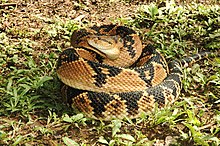Lachesis (genus)
| Lachesis | |
|---|---|
 |
|
| South American bushmaster, L. muta | |
| Scientific classification | |
| Kingdom: | Animalia |
| Phylum: | Chordata |
| Subphylum: | Vertebrata |
| Class: | Reptilia |
| Order: | Squamata |
| Suborder: | Serpentes |
| Family: | Viperidae |
| Subfamily: | Crotalinae |
| Genus: |
Lachesis Daudin, 1803 |
| Synonyms | |
|
|
Lachesis is a genus of venomous pit vipers found in forested areas of Central and South America. The generic name refers to one of the Three Fates in Greek mythology who determined the length of the thread of life. Three species are currently recognized.
Adults vary in length from 2 to 3 m (6.6 to 9.8 ft), although some may grow to as much as 4 m (13 ft). The largest known specimen was just under 4.5 m (15 ft), making it the longest venomous snake in the Western Hemisphere. Bushmasters are the longest type of viper in the world. L. muta is possibly the largest of the three species currently recognized, although more scant information suggest L. stenophrys broadly overlaps in size and may average at a similar size, while L. melanocephala is slightly smaller than the other two species. Although they are not the heaviest vipers, being surpassed in mass by the gaboon viper and the Eastern diamondback rattlesnake, large adults still can weigh up to 3 to 7 kg (6.6 to 15.4 lb). Bushmasters are sexually dimorphic in size, with males reaching larger sizes than females. The bushmaster's tail ends with a horny spine which it sometimes vibrates when disturbed in a manner similar to rattlesnakes. This led to some calling it 'the mute rattlesnake'.
Found in Central and South America, including the island of Trinidad.
Bushmasters lay eggs: about a dozen in an average clutch. The female reportedly remains with her eggs during incubation and may aggressively defend the nest if approached. The hatchlings average 30 cm (12 in) in length and are more colorful than the adults. Lachesis is thought to be unique among New World pit vipers by laying eggs rather than giving birth to live young, although some evidence suggests that the species Bothrocophias colombianus found in Colombia may do the same.
...
Wikipedia
